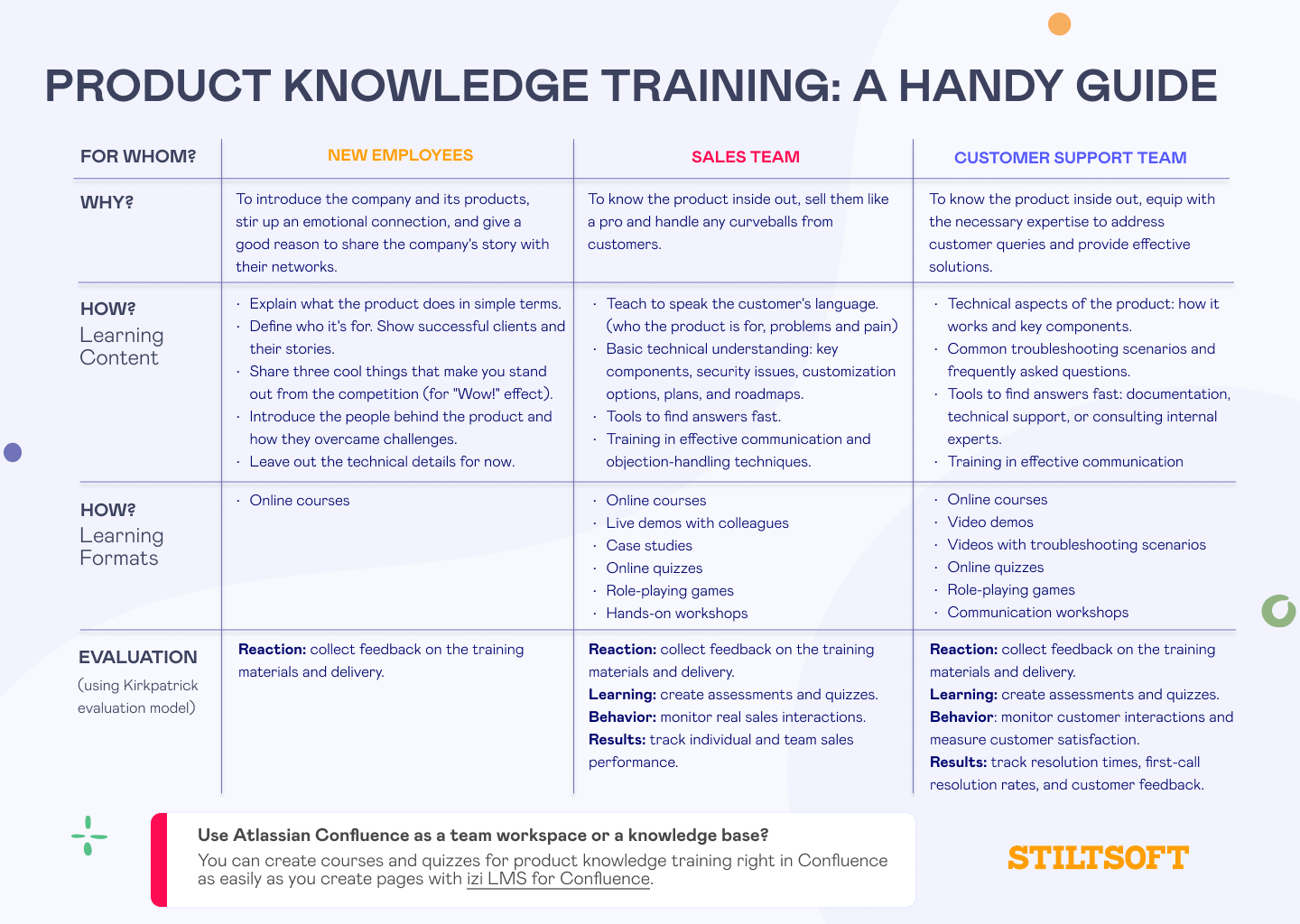Product Knowledge Training: A Handy Guide – Content, Formats, and Evaluation

Let’s explore the world of product knowledge training without going too deep into the ‘why’ – there are already many articles about that. The real question is, who can benefit most from it? In this article, we’ll discuss three groups of employees who can greatly benefit from some solid product knowledge training. For each group, we’ll outline a recipe for success, including setting goals, deciding what and how to learn, and evaluating results using the Kirkpatrick evaluation model.
Bonus: If your company uses Atlassian Confluence as its team workspace or knowledge base, we’ll also show you how to create product learning courses within it, effectively turning Atlassian Confluence into an LMS.
Product Knowledge Training for New Employees
Content: What to Include
- Explain what your product does in simple terms. Define who it is for.
- Show off your successful clients and their stories.
- Share three cool things that make you stand out from the competition – things that make them go “Wow!”
- Introduce the people behind the product and how they overcame challenges.
- Leave out the technical details and pricing for now. Just give them a list of resources if they want to learn more.
- Turn the training into an engaging story.
Learning formats
An online course with well-organized content is a great fit for product knowledge training for new employees. Create exceptional content, and then let automation handle the rest: new employees can easily join and complete the course, and HR can keep track of their progress.
Quick tip: If your company uses Atlassian Confluence as an intranet or a knowledge base, you can create learning courses and quizzes as easily as you create pages. Here’s how.
How to Evaluate
For newcomers, we assess their level of engagement and enthusiasm. Collect feedback on the training materials and delivery, and ask them to rate the course based on their level of interest.
Product Knowledge Training for the Sales Team

Content: What to Include
- Teach the sales team to understand and speak the customer’s language. Begin by introducing your clients through case studies and success stories. Help salespeople identify problems and pain points by guiding them to ask the right questions that reveal these issues. Encourage them to align your product’s benefits with solving these problems. Customer reviews can also be very helpful in this regard. In addition to discussing price, teach your sales team how to communicate the tangible return on investment (ROI) that your product or service offers. This skill is crucial.
- Provide basic technical understanding. We’re not turning our sales team into engineers, but they should grasp the basics: how the product works and its key components, security issues, customization options, plans, and roadmaps.
- Teach how to find answers quickly. Equip them with tools to find answers fast, whether it’s documentation, support, or internal experts.
- Include training in effective communication and objection-handling techniques.
Learning Formats
Online courses, live demos with experienced colleagues, case studies, online quizzes, role-playing games, and hands-on workshops.
How to Evaluate
Gather feedback from the sales team to see how they feel about the training. Create assessments and quizzes to measure their progress and see how well they can apply what they’ve learned. Observe behaviour during real sales interactions to check the impact of the training on sales techniques. Finally, results can be measured by tracking individual and team sales performance.
Product Knowledge Training for the Service Desk

Product knowledge training for service desk employees aims to equip them with the necessary expertise to address customer queries and provide effective solutions.
Content: What to Include
- Teach the technical aspects of the product: how the product works and its key components.
- Provide common troubleshooting scenarios and answers to frequently asked questions.
- Teach how to find answers quickly: provide them with tools to find answers fast, whether it’s through documentation, technical support, or seeking advice from an experienced colleague.
- Boost communication skills: service desk employees should be trained to actively listen, ask clarifying questions, and provide accurate and timely resolutions.
Learning Format
Online courses, video demos, prerecorded videos with troubleshooting scenarios, online quizzes, role-playing games, and communication workshops.
How to Evaluate
Ask for feedback from service desk employees to assess their reactions to the training. Create assessments and quizzes to evaluate employees’ ability to apply their product knowledge while assisting customers. Behaviour can be evaluated by monitoring customer interactions and measuring customer satisfaction. Measure results by tracking resolution times, first-call resolution rates, and customer feedback.
Product Knowledge Training in Confluence
It’s a smart move to use tools your team already knows to make training easier. If your team uses Confluence for teamwork, you can create courses and quizzes inside of it as well. Here’s why it’s great:
- Your colleagues already know how to use Confluence, so there is no need to teach them a new system.
- You don’t have to transfer your existing content to another platform, which also enhances the safety of your data.
- Everything happens in one place – in Confluence.
Turning Atlassian Confluence into an LMS is possible with IZI LMS for Confluence. The app is easy to install and natively fits Confluence’s interface. With its help, you can create courses and tests just like in top LMSs and use them for training, onboarding, and compliance. You can find more about creating courses with IZI LMS here.
To learn more about using Confluence for learning and onboarding, check out our other articles:



















